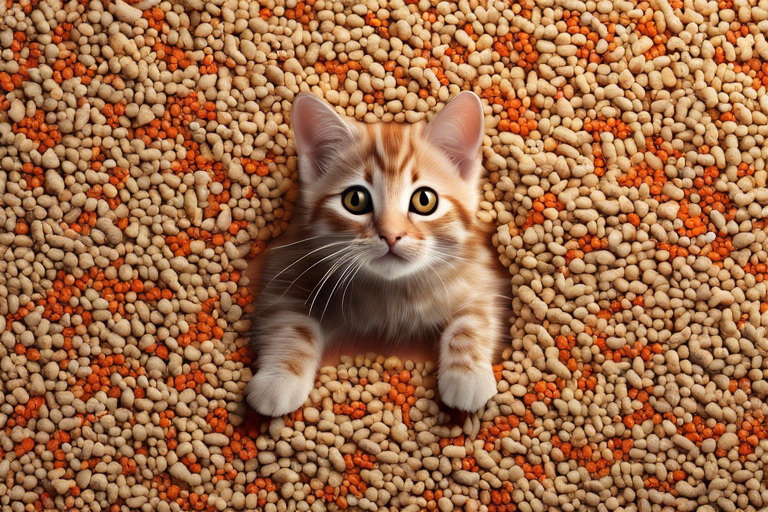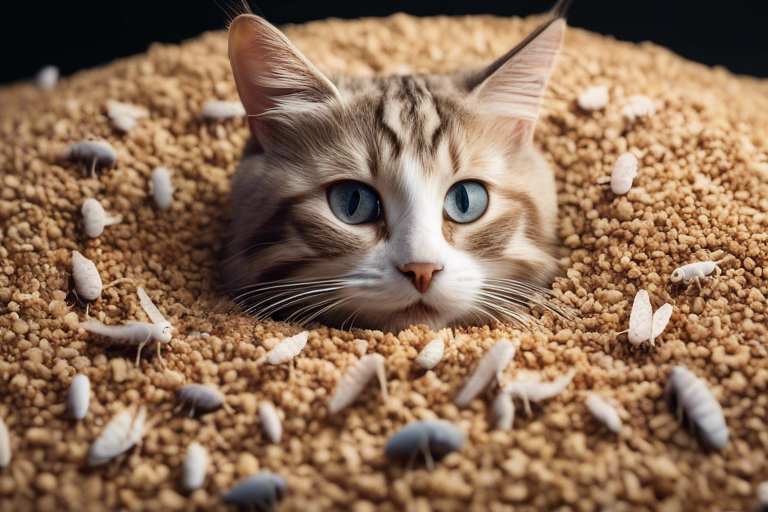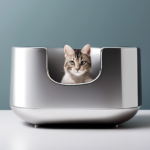Common Bugs in Cat Litter: A Comprehensive Guide to Identification and Elimination
Introduction
As a responsible cat owner, one of your top priorities is to provide a clean and hygienic environment for your furry companion. A crucial aspect of cat care revolves around maintaining a tidy litter box. However, bugs can become an unwelcome presence in this essential area. Understanding why bugs in cat litter boxes is the first step in effectively addressing the issue.
The Importance of a Clean Litter Box
A clean litter box is not only vital for your cat’s comfort but also for their overall health. Cats are known for their impeccable cleanliness, and a dirty litter box can lead to behavioral issues, such as litter box aversion or inappropriate elimination. Additionally, bugs in the litter box can pose health risks to both cats and humans, making it crucial to address infestations promptly.
Why Bugs Infest Cat Litter Boxes
Cat litter boxes provide an ideal environment for bugs due to the presence of organic material and moisture. Bugs, including fleas, ants, cockroaches, dust mites, and flies, are attracted to the scent of cat waste and the dampness of the litter. They can enter the box through various means, including hitching a ride on your cat or finding their way inside from the surrounding environment. Once bugs infest the litter box, they can quickly multiply and spread to other areas, causing further issues.
Common Bugs in Cat Litter
To effectively address bug infestations in your cat’s litter box, it’s essential to familiarize yourself with the common types of bugs you may encounter. Let’s explore the characteristics and potential risks associated with each bug.
Fleas
Fleas are small, wingless insects that are parasites, feeding on the blood of animals. They can transmit diseases to both cats and humans, including tapeworms, Bartonella (cat scratch fever), and flea allergy dermatitis. Flea allergy dermatitis is a skin condition that causes intense itching, hair loss, and skin irritation in cats. Fleas can infest your cat’s litter box if they hitch a ride on your cat’s fur or enter your home from outdoor areas.
Ants
Ants are attracted to the scent of cat urine and feces, making the litter box a prime target for infestation. While ants are not necessarily harmful to cats or humans, they can contaminate the litter box with dirt and bacteria. Ant infestations can make it difficult for your cat to use the litter box, potentially leading to litter box aversion and inappropriate elimination behaviors.
Cockroaches
Cockroaches are nocturnal insects attracted to warm and humid environments, making the litter box an ideal breeding ground for them. They can carry bacteria, viruses, and parasites, including salmonella and E.coli, which can cause food poisoning and other illnesses in cats and humans. Cockroach infestations in the litter box can create an unsanitary environment for your cat.
Dust Mites
Dust mites are microscopic bugs that feed on dead skin cells shed by cats and humans. They thrive in warm and humid environments, such as bedding, carpets, upholstery, and even cat litter boxes. While dust mites are not harmful to cats or humans, they can cause allergies and respiratory problems, such as asthma, in susceptible individuals. Taking measures to control dust mites in the litter box can contribute to a healthier environment for your cat.
Flies
Flies are attracted to the smell of cat waste and can easily infest the litter box. They can transmit diseases, including E.coli and salmonella, to cats and humans. Flies can also contaminate food and surfaces in your home with their feces, potentially causing illness. If flies lay eggs in the litter, it can result in a maggot infestation, which can irritate your cat’s skin and cause infection.

Identifying and Dealing with Fleas
Fleas are a common bug found in cat litter boxes, and addressing infestations promptly is crucial for the well-being of your cat and your household. Let’s explore how to identify flea infestations and effectively eliminate them.
Signs of Fleas in the Litter Box
Identifying fleas in the litter box may require close observation. Look for small, dark, moving specks resembling grains of sand. These specks are often flea feces, indicating the presence of fleas. Additionally, your cat may exhibit signs of flea infestation, such as excessive scratching, hair loss, and skin irritation.
Treating Fleas on Your Cat and in Your Home
To eliminate fleas from your cat and your home, a comprehensive approach is necessary. Start by treating your cat with a flea comb to remove adult fleas from their fur. Use a flea shampoo or spot-on treatment to kill any remaining fleas. It’s crucial to follow the instructions provided by your veterinarian or the product manufacturer.
In addition to treating your cat, thorough cleaning of your home is essential. Vacuum your home regularly, paying special attention to areas where your cat spends the most time. Wash your cat’s bedding and any other fabrics that may have come into contact with fleas. Consult with your veterinarian to determine if further pest control measures are necessary.
Tackling Ant Infestations in the Litter Box
Ants are another common bug that can infest your cat’s litter box. While they may not pose direct harm to cats or humans, their presence can be bothersome and unhygienic. Let’s explore how to identify ant infestations and effectively eliminate them from the litter box.
Recognizing Ants in the Litter Box
Identifying ants in the litter box is relatively straightforward. Look for trails of ants leading to and from the box, as well as ants actively exploring the area. Additionally, you may notice tiny ant hills or mounds near the litter box.
Effective Methods for Eliminating Ants
To get rid of ants in the litter box, it’s important to maintain cleanliness and implement preventive measures. Start by keeping the litter box clean and dry, as ants are attracted to damp environments. Regularly scoop the litter to remove any waste that may attract ants. Use an ant repellent around the area to deter ants from entering. If the infestation persists, consider contacting a pest control professional for further assistance.
Dealing with Cockroaches in the Litter Box
Cockroaches are resilient insects that can quickly infest your cat’s litter box if left unaddressed. Although they may not pose immediate harm to cats or humans, their presence can be unsanitary and unwanted. Let’s explore how to identify cockroach infestations and effectively eliminate them from the litter box.
Identifying Cockroach Infestations
Cockroach infestations in the litter box can be identified through visual cues. Look for live cockroaches scurrying in and around the litter box, especially during nighttime hours. Additionally, you may notice cockroach droppings, which resemble small, dark, cylindrical pellets.
Steps to Eradicate Cockroaches
To eliminate cockroaches from the litter box, it’s crucial to maintain cleanliness and implement preventive measures. Start by keeping the litter box clean and dry, as cockroaches are attracted to moisture. Seal any cracks or openings in your home to prevent cockroaches from entering. Use baits or traps to kill any remaining cockroaches. If the infestation persists or is severe, consider seeking professional pest control assistance.
Addressing Dust Mites in the Litter Box
Dust mites, although tiny, can be a nuisance in your cat’s litter box. While they may not pose direct harm to cats or humans, their presence can contribute to allergies and respiratory issues. Let’s explore how to identify dust mite infestations and effectively control them in the litter box.
Signs of Dust Mite Infestation
Identifying dust mites in the litter box may require microscopic examination. Look for signs of allergies in your cat, such as excessive scratching, sneezing, watery eyes, or skin rashes. Additionally, if you notice an increase in dust or allergens in your home, it may indicate a dust mite infestation.
Strategies for Controlling Dust Mites
Controlling dust mites in the litter box involves maintaining cleanliness and creating an unfavorable environment for their growth. Start by washing your cat’s bedding and any other fabrics that may have come into contact with dust mites in hot water. Regularly vacuum your home, using a vacuum with a HEPA filter to effectively capture dust mites. Consider using allergen-proof covers on your cat’s bedding to prevent dust mites from entering. If necessary, consult with a veterinarian for additional guidance.
Eliminating Flies from the Litter Box
Flies can be an annoyance in your cat’s litter box, potentially leading to further issues if left unaddressed. Let’s explore how to identify fly infestations and effectively remove them from the litter box.
Identifying Fly Infestations
Identifying fly infestations in the litter box is relatively straightforward. Look for the presence of flies, especially around the litter box area. Additionally, you may notice eggs or maggots in the litter if flies have laid their eggs there.
Preventing and Removing Flies
Preventing and removing flies from the litter box involves maintaining cleanliness and implementing preventive measures. Keep the litter box clean and dry, as flies are attracted to moisture and waste. Seal any openings or gaps in your home to prevent flies from entering. Use fly traps or sticky strips to catch any remaining flies. If the infestation persists, consult with a veterinarian or pest control professional for further guidance.
Preventing Bugs in Your Cat’s Litter Box
Preventing bugs from infesting your cat’s litter box is crucial for the well-being of your cat and the cleanliness of your home. Let’s explore effective preventive measures to keep the litter box bug-free.
Maintaining a Clean and Dry Litter Box
Regularly scooping the litter box is essential for maintaining cleanliness and preventing bug infestations. Remove waste from the litter box as soon as possible to deter flies, ants, and cockroaches from being attracted to it. Additionally, changing the litter frequently will prevent the buildup of bacteria and parasites.
Choosing the Right Type of Litter
The type of litter you choose can play a significant role in preventing bug infestations. Opt for litters that are less attractive to bugs, such as clay-based or silica-based litters. Avoid organic litters, as they can provide an ideal environment for bugs to thrive.
Implementing Regular Scooping and Cleaning
Regular scooping and cleaning of the litter box are essential preventive measures. Scoop the litter box at least twice a day to minimize the chances of attracting bugs. Additionally, do a full empty and clean of the litter box at least once a week, especially if you use natural litter.
Conclusion
Maintaining a bug-free litter box is crucial for the health and well-being of your cat. Bugs, such as fleas, ants, cockroaches, dust mites, and flies, can pose health risks to both cats and humans. By promptly addressing bug infestations, implementing preventive measures, and maintaining cleanliness, you can provide a safe and hygienic environment for your feline companion. Remember, if you suspect tapeworms or any severe infestation, it’s best to consult with a veterinarian for appropriate treatment.







Эффективная уборка квартиры в Новосибирске: лучшие услуги по доступным ценам
Клининговые услуги http://www.chisty-list.online.
СПб Уборка: Придайте своему жилью безупречный вид с нашей помощью
Клининг квартир http://chisty-list.ru/.
great article
Outstanding feature